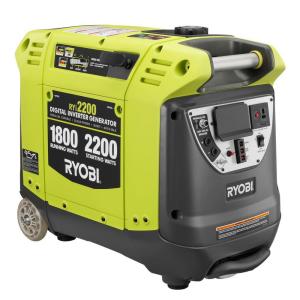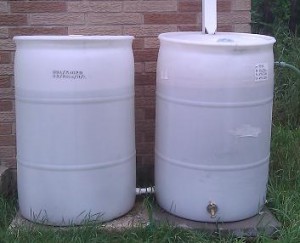Being Prepared For a Long Term Power Outage
While most of us spend a ton of time and resources planning and preparing for a future without having to work, I wonder how many people plan and prepare for shorter near term events, such as several days without power. Having an emergency fund of cash is great in a situation like this, but what if the stores are closed, or the card readers don’t work, or there is chaos because EVERYONE is rushing to the stores? In the past year we have had 2 power outages exceeding 5 days in duration due to severe weather. Here are some of my recommendations for making life more bearable during a long power outage.
Power Replacement:
Generators are expensive, but they can be worth having. A whole house generator system can easily set you back $5,000, so for most people I think this is a bit extreme. We have a 2200 Watt Ryobi Gas Generator, which cost $550, so far I am very happy with this purchase. The generator provides enough power to run a fridge, a chest freezer, and charge portable electronic devices (phones, ipad, portable dvd player) all at once. In the winter it is used to power an electric space heater. It can also be ran to the TV and DVD player to provide some entertainment.
This small generator is very useful, but one small investment can make it even more useful, A single circuit transfer switch By wiring the transfer switch in, this generator (or any generator for that matter) can be plugged into a circuit to directly power the boiler for the house. This $65 switch is invaluable in the winter. I actually plan on getting 2 switches, and using the second one for the circuit which powers our kitchen and living room outlets, so we don’t have to run extension cords through the house.
The major downside to a small generator that sips gas is that it is not capable of powering our well pump. Stored water can get you through a week or two, but anything longer and you will want access to the well. One option is a larger generator and a 240V transfer switch for the the pump, about $500 total. Another option is buying a simple pump, but that will run around $2K. Depending on your area, a supplemental driven well point with a hand pump may be a good plan, and can be done for around $200. For this to work the water table must be within 25 feet.
Gas storage: Different cities have different ordinances for how much fuel can be stored at your residence. 25 gallons is a normal limit. Most of us have at least 1 five gallon gas container. I recommend having at least 2, preferably 3. If you are using a gas guzzling large generator, then perhaps working towards 5 makes sense. Stored gas should be rotated and treated with Stabil.
Money and shopping:
In our most recent power outage virtually all businesses were cash only. The card systems were down at gas stations and grocery stores. That 6 months of cash in the bank does no good in this scenario. Keeping a couple hundred bucks in cash determines whether you can fuel up your car and grab some needed supplies. Don’t wait until an emergency happens to try to get out cash or get supplies. After a major storm, try finding a generator or even ice in stores, it isn’t going to happen. Easy to prepare food such as pop tarts and peanut butter go quickly as well.
Lighting:
This wasn’t as big of an issue in the storm we just had. In the summer here it is after 9:30 PM when the sun sets, in the winter, with the sky dark by 5PM supplemental lighting was more necessary. I recommend owning at least:
- 2 quality lanterns: Cost $50. I use an Energizer
and a Rayovac
led lantern. They both put out a decent amount of light, have multiple settings, and have a long battery life.
- several tap lights Cost: $10: These are great for trips to the bathroom or walking around the house, both cheap and convenient. I got a few at the dollar store and a few at Walmart.
- Several batteries, preferably rechargeable: Cost $40
- Plug in lamps with LED bulbs Cost $20: I see plug in lamps all the time at yard sales for under $5. When the generator is running the drain from a 60W equivalent led bulb is only 9 watts each, and having some real light is nice psychologically.
Water:
During a power outage for city dwellers the water tower will most likely be one of the first items to have power restored to it. For those of us with well water, once the power is out, we are out of water. The pressure tank will hold a few gallons, but this won’t last too terribly long.
Potable Water Storage: This is for drinking, food preparation, and sanitation. The 1 gallon per person per day rule would mean for a one week supply a family of four would store 28 gallons of potable water. Find a shelf in the basement or garage and store jugs of water in. Either buy the water at the store, or re-use jugs. I like to re-use the Gatorade containers. It is wise not to re-use milk or juice containers, because they can grow bacteria in them. If you have empty space in a chest freezer this can be a great place to store some water, just don’t fill the containers all the way. The ice will help keep food cold longer during an outage as well.
Non-Potable water: This water is solely for flushing the toilets. Originally I just filled up old cat litter container bottles just for this purpose, but I recently upgraded to a rain barrel system, and after this last outage, I am glad I did. 6 people living in a house for a week with no power, the toilets need to be flushed several times. For a total of $25 I set up a decent rain barrel system at my house that can store up to 100 gallons of water. Even a very light rain will refill the barrels.
Food:
When the power goes out, fridge and freezer food is in danger. In the winter it isn’t so bad. We have a few Rubbermaid totes to throw the food into and can store it outside in the winter if need be. If the power is out during the summer for any significant length of time, either coolers full of ice (if you are lucky enough to find some) or a generator will be needed to keep food cold. It is best to have a supply of self stable long term food storage available.
Cooking: Having a gas stove and oven is a big help during a power outage, but if you don’t have one, a propane camp stove is highly recommended. Having a low wattage microwave to use with a small generator is also a big plus.
Dishes: Having a supply of disposal dishes is important.I like to have a supply of the sturdy plastic plates and bowls, so that they can handle some decent food, and be microwaved. Multiply out a minimum of 3 sets per person per day. Cutting down on dishes to clean cuts down on water needed to be used.
Easy to prepare foods: With no oven, and at best a cook top and a microwave, food options are limited. Here is an area where we failed during the last outage. Sure, pop tarts and peanut butter sandwiches will get you by, but having a nice range of options is way better. Having meal plans in advance based on a no power scenario makes it much easier to adapt.
Spending some time and money on ensuring you are prepared for the majority of likely disaster scenarios is worth its weight in gold. The information above is certainly not all inclusive and doesn’t account for a true SHTF scenario, but having these supplies and plans in place can make a world of difference when faced with a prolonged outage.



Leave a Reply